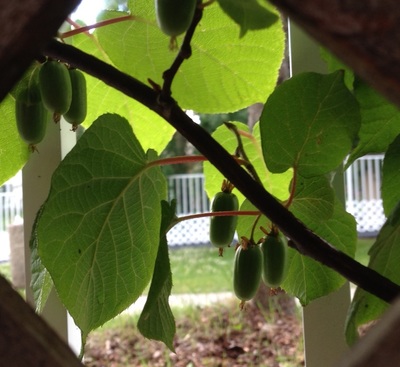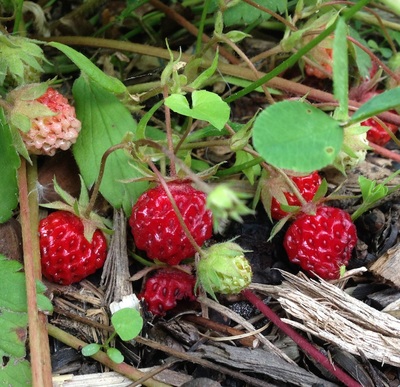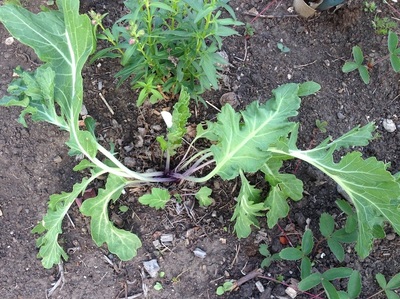What I love about a natural and edible landscape is the experimentation it allows us to do and the observation, learning and pleasure we derive from interacting with an evolving ecosystem. When you spend some time observing the changes and taking stock of what’s happening in your yard, you can make some interesting discoveries. Here are some things that have captured my interest in my yard this summer.
Arctic Beauty Kiwi is Growing Fruit!
I purchased a pot with a male and female kiwi and planted it in a fairly dry spot in almost full sun about 7 years ago. Some sources recommend that it be grown in part shade, in well-drained soil that should not be allowed to completely dry out. My kiwi certainly does not have the benefit of perfect conditions and while it has grown a little bit every year, it’s still only about 4 feet high. It now receives a little bit more shade from spruce trees in the area, and in April the temperature barely dipped below freezing. These conditions were favourable and for the first time, the vine is growing a few kiwis. They are still very small and I don't think there is more than a handful, but it’s exciting to see this exotic fruit develop into a berry-sized treat in our cold climate! Scroll down for a photo.
Wild Strawberry Bounty
Another sweet little treat is the wild strawberries that have been producing with abundance this early summer. I dug them up in a quarter of land that was being developed. Over the years, they have spread to cover bare soil, moving to sunnier spots but also doing well under the apple tree and other partially shaded areas. For many years, I rarely saw any fruit, especially in very dry areas. However, in the last couple of years, maybe due to warmer weather in April, I have been able to pick small handfuls of what I call “edible sunshine”.
Sea Kale Here to Stay?
Permaculture aficionados love to find unusual edible plants, especially when they are a perennial, reducing the amount of work it takes to plant every year. Sea Kale is an edible perennial listed in “Perennial Vegetables” by Eric Toensmeier and other sources. Many years ago, I met some friendly folks from the Devonian Botanic Garden who were selling seeds, and I was excited to discover sea kale. I planted the seeds but only a couple of them grew. Outdoors, they did not thrive and I lost one to a pest. After moving the remaining plant once, it seemed to be doing better, but the plant was small and I almost forgot about it. However, to my delight, it has almost doubled in size this year! Sea kale is listed in some sources as a Zone 5 or Zone 4 plant. So that’s a bit of a stretch for our gardens, but with a warming climate, we should be able to grow it in Edmonton. My spot in my Edmonton front yard is proving to be pretty good. It receives almost full sun and in winter, the plant is under a pile of snow from the driveway. I have renewed hope that it’s here to stay, and next year I may be able to harvest some leaves in early spring. For more info, visit this online info.
To grow your own sea kale, you can contact a local garden centre to ask if seeds or plants can be ordered in. Apache Seeds had some seeds this spring from Sutton (UK), but you’ll have to put this on the list and make some calls for 2017. If you want to order your own, this Canadian company has it listed.



 RSS Feed
RSS Feed